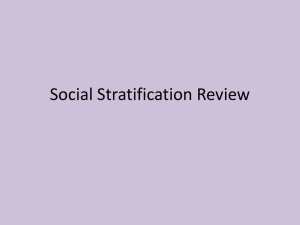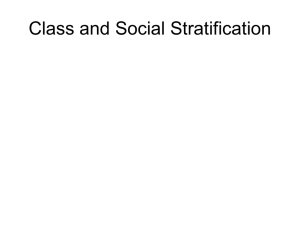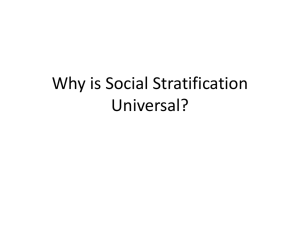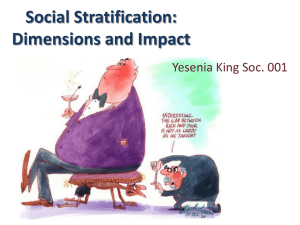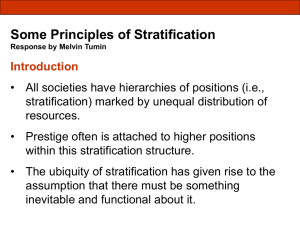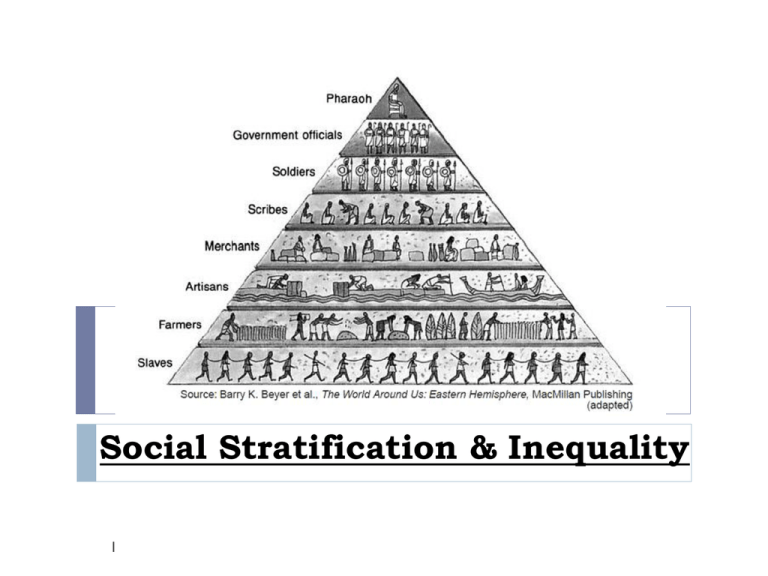
Social Stratification & Inequality
1
SOCIAL STRATIFICATION & INEQUALITY
Social Inequality refers to any differences that result in
some people having more socially valued characteristics
than others (Holborn & Langley 2002, 6).
Social Stratification is the hierarchical ordering of groups
in society (Haralambos & Holborn 2000).
So groups are put into different categories (based on
wealth, power, prestige, colour, etc) and placed in an order
or ranked at different levels/strata.
2
SOCIAL STRATIFICATION & INEQUALITY
Society is stratified based on different elements:
3
Age
Race
Ethnicity
Gender
Class
Caste
Occupation/Position in society
PYRIAMID – SOCIAL CLASS (WEALTH)
4
PYRIAMID – SOCIAL CLASS (WEALTH)
5
PYRIAMID – FEUDAL JAPAN (OCCUPATION)
6
SOCIAL MOBILITY
Social Mobility is the movement between the strata or
the ability to move up or down that hierarchy or ladder.
You can gain mobility through education, occupation, power,
contacts, skin colour, religion, etc.
Inter-generational mobility occurs when there is mobility
between two generations. For example, a son’s mobility is
compared with his father’s.
Intra-generational mobility occurs within one generation;
this occurs over the course of one’s lifetime. For example,
you may compare your status when you are 40 years as
opposed to when you were 18 years old.
7
TYPES OF SOCIAL STATUS
Your status is your social position or standing in society.
There are two main types of statuses:
1. Ascribed Status – is the status that you are born with
and it is usually difficult to change (for example: sex, skin
colour, race, caste) and it occurs in a closed stratification
system.
2. Achieved Status – is the status that you have achieved
or attained on the basis of merit and occurs in an open
stratification system. Education and class are examples of
achieved status.
8
TYPES OF SOCIAL STRATIFICATION
SYSTEMS
There are two main types of these systems worldwide:
1. Closed Stratification Systems – Closed systems are
those whereby the individuals cannot move up or
down the hierarchy or ladder. Examples: Caribbean
Slavery System, India’s Caste System
2. Open Stratification Systems – Open systems
however, mean that the mobility is more fluid and
individuals can move up or down the ladder. Examples:
USA, T&T, and most democratic societies. This is also
called a meritocratic society (meritocracy).
9
INDIA’S ANCIENT CASTE SYSTEM
10
THE UNDERCLASS
As seen in the social pyramid in India, there is a caste
called the “untouchables.” In all stratification systems,
there is a portion of the population who is deemed as the
“underclass.”
The underclass is the class that occupies the lowest
possible position in the hierarchy.
These people are unlikely to improve their situation either
by choice or circumstance.
Karl Marx deemed this part of the population, the
lumpenproletariat.
Contemporary Sociologists call these people “victims” or
marginalized elements in the society who operate outside
the wage-labour system. For e.g. – beggars, prostitutes,
drug dealers, etc.
11
THE UNDERCLASS
The characteristics of the underclass include:
1.
2.
3.
4.
5.
6.
Poverty
Crime
Unemployment
Poor education
Dependency
Teenage Pregnancy
Oscar Lewis (1969) created a theory called the “Culture
of Poverty”. He ascertained that that the subculture of
the poor perpetuates poverty and children are therefore
socialized into this culture, thus perpetuating the cycle of
poverty.
In Lewis’ theory, he believed that the underclass is
trapped in poverty for generations.
12
CULTURE OF POVERTY
Lewis identified the following in his cycle of poverty.
1.
Many children born into poverty remain under-weight as a baby due to a poor diet.
2.
A minimal parental input means that a child born into poverty is under-prepared or
simply not prepared for pre-school or primary school education. This immediately
puts that child at a disadvantage compared to others from a different background.
3.
A lack of material things within a school when compared to others reinforces that
child’s background – an ‘antique’ mobile phone for instance.
4.
Many children born into poverty attend secondary schools that get some of the
worst exam results, thus perpetuating their chances of being successful.
5.
With minimal educational qualifications, a child born into poverty has little chance of
finding a long term career. Higher education for many is a dream. The bulk of people
who do technical vocational such as YTEPP come from poorer backgrounds.
6.
Should they get a job, it is likely to be short-term and earning the government’s
minimum wage. Therefore, they get all their money because they do not pay taxes
but they remain in poverty because of the high standard of living.
7.
Should they get married, their children will be born into poverty. As parents, they will
have seen how education has ‘failed them’ and probably reinforce onto their children
that ‘education does not matter’ and ‘it’s not important’ and the cycle of poverty
13 continues for another generation.
STRATIFICATION SYSTEMS IN T&T
In Trinidad & Tobago, we have moved from a closed to an
open stratification system.
During slavery, stratification was mainly determined by
race & colour of one’s skin (ascribed statuses). Therefore,
it was a closed stratification system, as mobility was not
possible.
In this type of system, your social status depended on
your skin colour with the fairest being the highest strata
and darkest being the lowest.
14
STRATIFICATION SYSTEMS IN T&T
Following the PNM’s win in 1956, the stratification system
began to become more open as status became more
achieved.
Education paved the way for our system of stratification
to become open and meritocratic.
However, many people do not believe that we have an
entirely open stratified system and many argue that it is
mixed and status is still highly attributed to race. Others
look at the implications of wealth, power and prestige on
influencing one’s status.
Today, which class is the underclass in T&T?
15
STRATIFICATION SYSTEMS IN T&T
Like all Caribbean countries, the stratification system in
T&T has been influenced by its history of Colonialism,
Plantation Slavery and Indentureship.
Although, most of these territories are currently politically
independent nation-states, the legacy of their history have
continued to impact upon their individual social structure.
There are three theories that explain stratification in T&T:
1.
2.
3.
16
Plantation Society Theory
Plural Society Thesis
Creole Society Theory
PLANTATION SOCIETY THEORY –
GEORGE BECKFORD
The most prominent feature of the traditional Caribbean society was the
plantation society.
George Beckford (1983), like many others, perceived the plantation as a total
economic institution.
Features of the Plantation society include:
the prevalence of monocrop agriculture;
marginalization of the peasantry;
dependence on foreign capital and enterprise as the main
investors;
dependence on foreign markets for our crops;
forced labour systems;
a taste for foreign products;
lack of democratic tradition because of the long existence of
slavery;
social stratification based on the gradations of colour and race.
PLANTATION SOCIETY THEORY –
GEORGE BECKFORD
This theory of Caribbean society, though based on the original plantation
model, can still be applied to contemporary Caribbean societies.
Upper Class/caste/ruling elites (traditionally white) – own wealth, means
of production and political power.
Intermediate Class/caste (mulatto/browns) – usually educated, own
some wealth, (desire but) lack political power.
Working Class/caste (blacks) – slaves, uneducated, lack wealth and
political power.
Academics contend that the Upper Class on the contemporary Caribbean
continues to be whites. These either descents of the old planter class
aristocracy who still own most of the islands supermarkets, hotels, land,
transportation, control import prices. They continue to own and control a
significant proportion of the territory’s wealth, and as such wield great
economic, social and political power. The non-white populations continue
to be situated at the lower end of the social strata. They constitute the
public servants and unskilled workers in the society.
PLURAL SOCIETY THESIS –
M.G. SMITH
The Plural Society Theory, first conceptualised by J.S. Furnivall
(1944) and further promulgated by M.G. Smith (1960), posits
that societies with many cultures and ethnicities, such as those
in the Caribbean, co-exist but only do so in the marketplace.
Ethnic groups keep their own distinct cultural practices and
belief systems with little or no inter-mixing and the sole
interaction among the groups is the economic aspect or the
marketplace.
Diverse groups share the same physical space, but there is
little or no consensus among the groups and they keep a
social distance or are kept at a social distance by laws,
customs or social pressure in interpersonal relations.
Societies were therefore maintained only by the superior
force of the European colonial power.
PLURAL SOCIETY THESIS –
M.G. SMITH
Smith argues that most societies in the Caribbean are plural
societies where there exists significant cultural diversity and
race antagonism
Various ethnic groups have their own socio-economic
institutions but not their own political system
It is the cultural and race diversity that causes the discord
between the cultural groups.
Social inequality exists between ethnic groups. These
inequalities are transient depending on the social actor.
Factors of colour, religion, culture, economic background,
education all influence positioning within the social strata.
CREOLE SOCIETY THEORY –
EDWARD KAMAU BRAITHWAITE
Edward K. Braithwaite adds a different perspective on the
composition of Caribbean societies.
Whereas the Plural Society Thesis argues that the groups live
separate and apart from each other (except in the
marketplace), Braithwaite posits that the cultures of the major
groups (mainly the Europeans and Africans) are mixed or
combined creating a unique ‘Creole’ culture.
Creolisation is a process of change and adaptation that occurs
over time.
In the Caribbean, many aspects of our culture, such as music,
art, languages, religious rituals, cuisine and people, is
represented by this notion of Creolisation.
CREOLE SOCIETY THEORY –
EDWARD KAMAU BRAITHWAITE
Is described as a hybrid/syncretic/new society.
The stratification system is informed by an ascriptiveparticularistic value system (Lloyd Braithwaite)
Ryan contends however that the ascriptive-particularistic
value system that informed the pre-independence era, gave
way to meritocracy in the post-independence era. Some
elements of the ascriptive value system continue to exist.
BIBLIOGRAPHY
Ryan, Selwyn. “Social Stratification in Trinidad and
Tobago: Lloyd Braithwaite Revisited.”
Reddock, Rhoda. “Social Mobility in Trinidad and
Tobago.”
Holborn, Martin & Peter Langley. 2002. Haralambos
and Holborn: Sociology: Themes and
Perspectives – Student Handbook. London:
HarperCollins Publishers Ltd.
McIntyre, Lisa. 2006. The Practical Skeptic: Core
Concepts in Sociology. 3rd Ed. New York, NY: Mc
Graw Hill.




